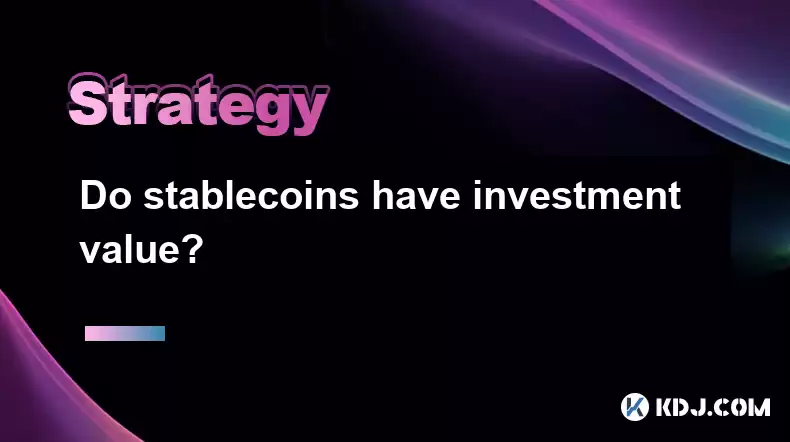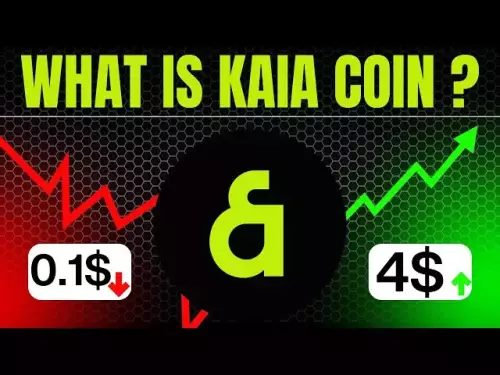-
 bitcoin
bitcoin $112715.707551 USD
-1.71% -
 ethereum
ethereum $4101.475385 USD
-3.01% -
 tether
tether $1.000644 USD
-0.02% -
 bnb
bnb $1207.619465 USD
-6.77% -
 xrp
xrp $2.501451 USD
-3.98% -
 solana
solana $202.947124 USD
-3.32% -
 usd-coin
usd-coin $1.000295 USD
0.04% -
 dogecoin
dogecoin $0.203884 USD
-4.47% -
 tron
tron $0.317154 USD
-1.72% -
 cardano
cardano $0.695009 USD
-4.43% -
 hyperliquid
hyperliquid $38.853961 USD
-8.23% -
 chainlink
chainlink $18.988674 USD
-4.64% -
 ethena-usde
ethena-usde $1.000233 USD
-0.03% -
 stellar
stellar $0.337050 USD
-3.63% -
 bitcoin-cash
bitcoin-cash $536.861728 USD
-1.28%
Do stablecoins have investment value?
Stablecoins offer price stability to reduce volatility, enable international payments, access DeFi applications, and provide investment opportunities, making them valuable additions to a diversified portfolio, although they face risks such as counterparty and smart contract risks, regulatory uncertainties, and market volatility.
Jan 08, 2025 at 09:52 pm

Key Points
- Understanding the Nature and Types of Stablecoins
- Assessing the Stability Mechanisms of Stablecoins
- Evaluating the Investment Potential of Stablecoins
- Reviewing Stablecoin Risk Considerations
- Identifying and Comparing Popular Stablecoins
- Exploring Use Cases and Adoption of Stablecoins
- Assessing the Regulatory Framework Surrounding Stablecoins
Do Stablecoins Have Investment Value?
Understanding Stablecoins and Their Types
Stablecoins are cryptocurrencies designed to maintain a stable value relative to a fiat currency (e.g., USD) or other assets (e.g., gold). They aim to provide a less volatile alternative to traditional cryptocurrencies like Bitcoin while still offering the benefits of blockchain technology. Stablecoins can be classified into several types:
Fiat-Collateralized Stablecoins: Backed by reserves of fiat currency held in a trusted third-party account.Crypto-Collateralized Stablecoins: Over-collateralized by other cryptocurrencies, ensuring stability even during market fluctuations.Algorithmic Stablecoins: Use smart contracts to manage the supply and demand of the stablecoin, adjusting the circulating supply to maintain its peg.Commodity-Collateralized Stablecoins: Backed by physical assets such as gold or real estate, providing stability through the underlying asset's value.
Assessing Stablecoin Stability Mechanisms
The stability of stablecoins is crucial for their investment value. The mechanisms employed to maintain stability vary:
Centralized Control: Fiat-collateralized stablecoins rely on trusted third parties to manage the reserves and ensure the peg.Over-Collateralization: Crypto-collateralized stablecoins maintain a collateral ratio above 100%, providing a buffer against market volatility.Expansionary and Contractionary Monetary Policy: Algorithmic stablecoins use a feedback loop to adjust the supply, contracting it during price increases and expanding it during price decreases.Commodity Backing: Commodity-collateralized stablecoins' stability is tied to the underlying asset's value and the reliability of the custodian.
Evaluating Stablecoin Investment Potential
Stablecoins present potential investment opportunities due to their:
Price Stability: Their peg to fiat currencies or other assets minimizes price fluctuations, reducing the risk of large losses.Interest Earnings: Some stablecoins offer interest returns through lending or staking, providing passive income for investors.Diversification Option: Stablecoins can diversify a portfolio, reducing overall volatility while maintaining exposure to the crypto market.Gateway to DeFi: Stablecoins serve as a medium of exchange for decentralized finance (DeFi) applications, enabling access to various yield-generating protocols and markets.
Stablecoin Risk Considerations
Despite their stability, stablecoins face certain risks:
Counterparty Risk: Centralized fiat-collateralized stablecoins rely on the solvency and reliability of the institutions holding the reserves.Smart Contract Risk: Algorithmic stablecoins depend on the integrity of their smart contracts, which could be compromised through hacks or exploits.Regulatory Uncertainties: Stablecoins fall under regulatory scrutiny, with unclear regulations in many jurisdictions, potentially affecting their stability and investment value.Market Volatility: While stablecoins aim for stability, they can experience temporary price fluctuations during prolonged market turbulence.
Popular Stablecoins and Their Features
Several stablecoins have gained significant adoption:
Tether (USDT): Fiat-collateralized stablecoin, largest by market capitalization.USD Coin (USDC): Fiat-collateralized stablecoin, backed by a consortium of regulated exchanges and custodians.Binance USD (BUSD): Fiat-collateralized stablecoin, issued by cryptocurrency exchange Binance.Dai (DAI): Algorithmic stablecoin, collateralized by Ether (ETH).TrueUSD (TUSD): Fiat-collateralized stablecoin, audited by a licensed accounting firm.
Stablecoin Use Cases and Adoption
Stablecoins have numerous use cases in the crypto ecosystem:
Trading: Replacing fiat currencies in cryptocurrency markets, minimizing conversion fees and delays.Cross-Border Payments: Simplifying and reducing costs associated with international money transfers.DeFi Applications: Facilitating lending, borrowing, and yield farming activities within decentralized finance platforms.Remittances: Providing a quick and cost-effective way to send money across borders.
Assessing Regulatory Framework for Stablecoins
Regulatory efforts are underway to address the risks associated with stablecoins:
Central Bank Digital Currencies (CBDCs): Government-issued digital currencies aiming to bridge the gap between traditional fiat and cryptocurrencies.Stablecoin Legislation: Some jurisdictions have implemented or are considering legislation to regulate stablecoins, including anti-money laundering (AML) and know-your-customer (KYC) requirements.Banking Industry Initiatives: Banks and financial institutions are collaborating to develop stablecoins backed by traditional banking reserves.
FAQs
What are the benefits of buying stablecoins?Stablecoins offer price stability, reduce volatility, facilitate international payments, enable access to DeFi applications, and provide potential investment returns.
What are the risks of investing in stablecoins?Stablecoins face counterparty risk, smart contract risks, regulatory uncertainties, and market volatility, which can affect their price stability and investment value.
What are the best ways to choose a stablecoin for investment?Consider the stability mechanism used, the credibility of the issuing entity, the regulatory environment, and the use cases relevant to your investment strategy.
What are the potential future applications of stablecoins?Stablecoins have the potential to revolutionize international payments, cross-border remittances, and traditional banking by providing a bridge between fiat currencies and the crypto ecosystem.
Disclaimer:info@kdj.com
The information provided is not trading advice. kdj.com does not assume any responsibility for any investments made based on the information provided in this article. Cryptocurrencies are highly volatile and it is highly recommended that you invest with caution after thorough research!
If you believe that the content used on this website infringes your copyright, please contact us immediately (info@kdj.com) and we will delete it promptly.
- MEXC's Explosive Growth: Trading Volume and Token Gains in Focus
- 2025-10-15 18:25:16
- Pudgy Penguins Price Prediction: Bull Flag Hints at Breakout!
- 2025-10-15 18:45:14
- GateToken Q3 2025 Onchain Destruction: Deflationary Strategy in Action
- 2025-10-15 18:45:14
- Chainlink (LINK): Super Bullish Signals Amidst Institutional Adoption
- 2025-10-15 18:25:16
- Arbitrum (ARB) Comeback: Is a Price Surge on the Horizon?
- 2025-10-15 19:05:12
- Coinbase's India Crypto Play: A Bullish Bet on CoinDCX and the Future of Digital Assets
- 2025-10-15 18:30:01
Related knowledge

Practical parameter settings for a Bitcoin multi-timeframe moving average system
Sep 18,2025 at 10:54pm
Optimizing Timeframe Combinations for Bitcoin Trading1. Selecting appropriate timeframes is crucial when building a multi-timeframe moving average sys...

How can I filter out false breakouts in Dogecoin high-frequency trading?
Sep 22,2025 at 01:00am
Understanding False Breakouts in Dogecoin Trading1. A false breakout occurs when Dogecoin's price appears to move beyond a defined support or resistan...

Techniques for identifying tops and bottoms in the Bitcoin on-chain NVT model
Sep 20,2025 at 07:54pm
Understanding the NVT Model in Bitcoin Analysis1. The Network Value to Transactions (NVT) ratio is often described as the 'P/E ratio' of the cryptocur...

What does the surge in open interest in Bitcoincoin futures mean?
Sep 20,2025 at 11:18pm
Understanding the Surge in Dogecoin Futures Open Interest1. A surge in open interest within Dogecoin futures indicates a growing number of active cont...

How can I use the Ethereum USDT premium to gauge market sentiment?
Sep 18,2025 at 11:55pm
Understanding the Ethereum USDT Premium1. The Ethereum USDT premium refers to the price difference between USDT (Tether) traded on Ethereum-based plat...

What should I do if Ethereum staking yields decline?
Sep 20,2025 at 06:18am
Understanding the Causes Behind Declining Ethereum Staking Yields1. The Ethereum network transitioned to a proof-of-stake consensus mechanism with the...

Practical parameter settings for a Bitcoin multi-timeframe moving average system
Sep 18,2025 at 10:54pm
Optimizing Timeframe Combinations for Bitcoin Trading1. Selecting appropriate timeframes is crucial when building a multi-timeframe moving average sys...

How can I filter out false breakouts in Dogecoin high-frequency trading?
Sep 22,2025 at 01:00am
Understanding False Breakouts in Dogecoin Trading1. A false breakout occurs when Dogecoin's price appears to move beyond a defined support or resistan...

Techniques for identifying tops and bottoms in the Bitcoin on-chain NVT model
Sep 20,2025 at 07:54pm
Understanding the NVT Model in Bitcoin Analysis1. The Network Value to Transactions (NVT) ratio is often described as the 'P/E ratio' of the cryptocur...

What does the surge in open interest in Bitcoincoin futures mean?
Sep 20,2025 at 11:18pm
Understanding the Surge in Dogecoin Futures Open Interest1. A surge in open interest within Dogecoin futures indicates a growing number of active cont...

How can I use the Ethereum USDT premium to gauge market sentiment?
Sep 18,2025 at 11:55pm
Understanding the Ethereum USDT Premium1. The Ethereum USDT premium refers to the price difference between USDT (Tether) traded on Ethereum-based plat...

What should I do if Ethereum staking yields decline?
Sep 20,2025 at 06:18am
Understanding the Causes Behind Declining Ethereum Staking Yields1. The Ethereum network transitioned to a proof-of-stake consensus mechanism with the...
See all articles


























![Staking ATH: How To Stake $ATH in October 2025 with 523% APY — [Step-By-Step Guide] Staking ATH: How To Stake $ATH in October 2025 with 523% APY — [Step-By-Step Guide]](/uploads/2025/10/15/cryptocurrencies-news/videos/staking-ath-stake-ath-october-apy-stepstep-guide/68eef94d80903_image_500_375.webp)















































